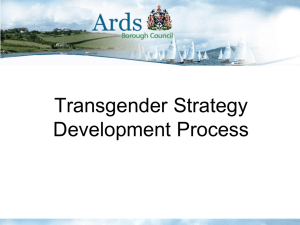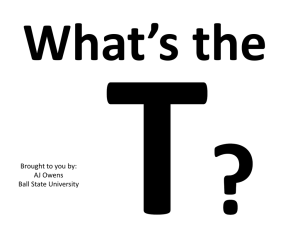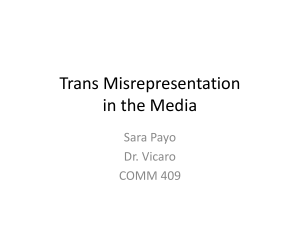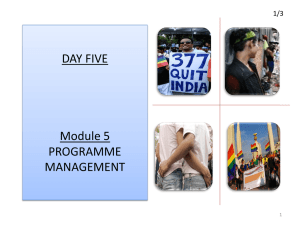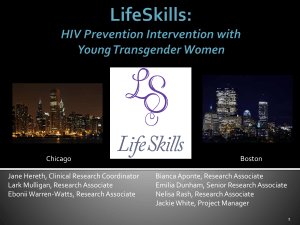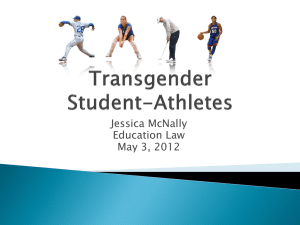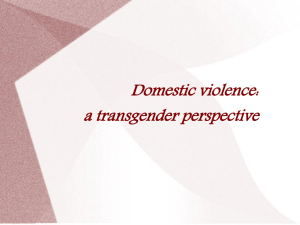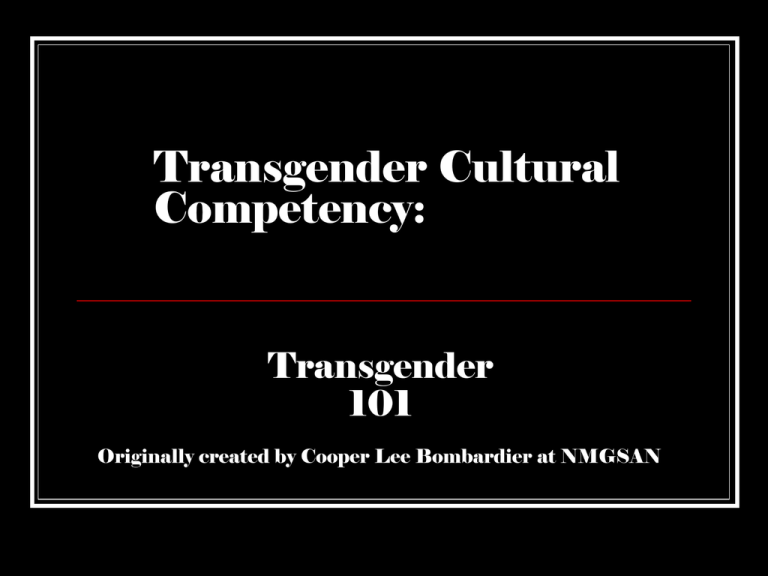
Transgender Cultural
Competency:
Transgender
101
Originally created by Cooper Lee Bombardier at NMGSAN
Who is this person in the front of the
room?
Basic Concepts:
Sex (assigned at birth)
Sexual Orientation
Gender Identity
Gender Expression
Question:
But, you can only be either
male or female, right?
The Gender Binary:
The concept
based upon
societal “norms”
that one can be
either a man or a
woman, only.
He!
She!
What is “Transgender”?
“Individuals whose gender identity, expression, or
behavior is not traditionally associated with their
birth sex. Some transgender individuals
experience their gender identity as incongruent
with their anatomical sex and may seek some
degree of sex reassignment surgery, take
hormones or undergo other cosmetic procedures.
Others may pursue gender expression (masculine
or feminine) through external self-presentation
and behavior.”
-The Leadership Campaign on AIDS
What is “Transgender”?
“Individuals whose gender identity, expression, or
behavior is not traditionally associated with their
birth sex. Some transgender individuals
experience their gender identity as incongruent
with their anatomical sex and may seek some
degree of sex reassignment surgery, take
hormones or undergo other cosmetic procedures.
Others may pursue gender expression (masculine
or feminine) through external self-presentation
and behavior.”
-The Leadership Campaign on AIDS
Fluidity
Being Transgender does not mean that you
are assigned a label or category or that you
wish to conform to the gender binary.
Many people, especially younger urban
transgender people, are embracing identity
terms like genderqueer, gender fluid, bigender, tri-gender, etc.
“Transgender” is considered an umbrella term.
Cross-dresser
Transvestite/fetishist
Passing/non-passing
Bi-gendered
Transgender
Transsexual
Transwoman/transman
More
Drag king/Drag queen
Androgynous
Genderqueer
Where do I fit?
BOTH
Birth Sex: Male, Female, DSD
Gender Identity: Masculine, Feminine,
Neither, Both, Something Else!
Gender Expression: Masculine,
Feminine, Androgynous, Something Else!
Sexual Orientation: Straight, Gay, Bi,
Pansexual, Asexual, Something Else!
FEMALE
MALE
NEITHER
What are Disorders of Sex
Development (Intersex)?
“Intersex” is a general term used for a variety of conditions in which
a person is born with a reproductive or sexual anatomy that doesn’t
seem to fit the typical definitions of female or male. For example, a
person might be born appearing to be female on the outside, but
having mostly male-typical anatomy on the inside. Or a person may
be born with genitals that seem to be in-between the usual male
and female types—for example, a girl may be born with a
noticeably large clitoris, or lacking a vaginal opening, or a boy may
be born with a notably small penis, or with a scrotum that is divided
so that it has formed more like labia. Or a person may be born with
mosaic genetics, so that some of her cells have XX chromosomes
and some of them have XY.
-From The Intersex Society of North America
Things to remember:
Transgender people have always been a
part of the modern Lesbian, Gay, Bisexual
Civil Rights Movement!
However, not all trans people identify as
being part of the LGBT Community
Trans people identify as queer, straight, bi,
gay, lesbian, asexual, pansexual, etc., just
as non-trans people do!
Things to remember:
Paperwork/documents
Policies/procedures
Laws
Data
Safety – physical, mental, emotional,
spiritual
More terms:
Male-to-female (MTF or M2F):
A person assigned male at birth who lives,
presents or transitions to female.
Transwoman
Uses female pronouns : she, her, hers
More terms:
Female-to-male (FTM or F2M):
A person assigned female at birth who lives,
presents or transitions to male.
Transman
Uses male pronouns; he, him, his
More terms:
Transition:
The process of medically, legally and socially
changing from one gender to another.
Why do people transition?
Why would someone who is trans decide not to
transition?
Remember, not all transgender people are transsexual and
may not be seeking medical treatment to change their sex!
More terms:
Passing:
To be seen or “read” as the gender you are
presenting as, or to go undetected as being
transgender
Stealth:
To live passing as non-trans and without
disclosing status as transgender
Problems with
passing/not passing
Some trans people who may want to pass cannot
for many reasons:
Age at which they transitioned
Access to medical care/ medical transition
Genetics
It is important not to assume that all trans people
want to pass and important not to discriminate
against trans people who do not pass!
Problems with
passing/not passing
Safety - risk of violence & discrimination
Favoritism - we privilege those who “fit in”
with the gender binary over those who do
not
Not everyone wants to pass, tries to pass
or can pass!
Inappropriate Terms:
Tranny
She-male
He-she
Transvestite
Hermaphrodite
Sex-change, sex change operation
Bio-male, bio-female (controversial)
Why Are People Transgender?
Cultures
Biology
Medical theories
Psychological factors
Right to Choose
Trans people have always existed in many
Western and Non-western cultures throughout
history!
How many transgender people
are there?
We don’t know for sure:
No one is collecting this data
US Census doesn’t track it
Many trans people are not public about their identities
National Center for Transgender Equality
estimates between ¼ and 1% of the population is
transsexual.
American Psychological Association estimates the
prevalence of transsexualism are about 1 in
10,000 for biological males and 1 in 30,000 for
biological females.
Is being Transgender
a mental illness?
Transgender identity is not a mental illness that can be
cured with treatment.
Transgender people experience a persistent and
authentic difference between our assigned sex and our
understanding of our own gender, for some this leads to
emotional distress.
This emotional distress is often relieved by freely
expressing our genders, and for some, making a
physical transition.
For people who identify as transgender, counseling
alone without medical treatment is often not effective!
Is being Transgender
a mental illness?
Gender Identity Disorder is listed in the
Diagnostic and Statistical Manual-4th Ed.
(DSM-IV), used by mental health
professionals to diagnose psychological
conditions.
Until 1973, Homosexuality was considered
a mental illness.
Is being Transgender
a mental illness?
A psychological condition is considered a
mental illness only if it causes distress or
disability. Many transgender people do not
experience their transgender feelings and
traits to be distressing or disabling, which
implies that being transgender does not
constitute a mental disorder per se.
–American Psychological Association
Gender Identity Disorder
The GID diagnosis is controversial both within the
mental health professions and the trans
community.
Pro-diagnosis: U.S. requires diagnosis to justify
medical or psychological treatment, so diagnosis
is essential to ensure access to care
Anti-diagnosis: it inappropriately pathologizes
gender variance and should be eliminated
Transgender Etiquette:
Always call a person by their chosen name
and preferred pronoun!
If you do screw up pronouns or name,
apologize briefly and move on!
Transgender Etiquette:
Never ask a trans person if they have had
“the surgery”, or if they plan to!
Nor should you ask about other medical info,
unless it directly pertains to treatment sought
from you!
Remember that just because someone is
trans, that doesn’t mean it is okay to ask
them questions about their bodies!
Transgender Etiquette:
Respectfully ask someone how they would
like to be addressed if you are not sure!
“Which pronoun do you prefer?”
“How would you like to be referred to, in terms of
gender?”
Transgender Etiquette:
Don’t interrogate trans people about family
or personal life unless we bring it up to you!
Don’t assume that because we are trans
we want to talk about it constantly!
Transgender Etiquette:
Do not sensationalize or sexualize trans
bodies!
Refrain from reminding us how different we
look than ‘before”, how you liked us better
‘before’, how hot we are now (WE KNOW),
or how much we look like ‘real guys’ or ‘real
girls’, etc!
OUTING:
Never ‘Out’ someone as transgender
without their permission!
BEFORE you Out someone:
Ask yourself WHY you wish to OUT themWHO is it benefiting?
Think about what kind of impact OUTING this
person will have on their physical safety,
employment, housing, etc.
OUTING:
Remember that many transpeople are killed every
year just because other people find out that they
are trans!
Some trans folks prefer never to be ‘out’ as trans
or don’t even consider themselves to be ‘trans’.
Honor their privacy!
Even folks who work for trans rights deserve
privacy – let them out themselves where and
when they want to!
How to be an awesome Ally &
Provider!
Remember the Etiquette tips!
Be mindful of trans people in office or
waiting room
Don’t police public restrooms
Don’t ask about a trans person’s genitals
unless it has to do DIRECTLY with the care
or treatment they are seeking from you!
How to be an awesome Ally &
Provider!
Never treat trans people as if they are
being risky with their health!
Remember, being transgender is not a
‘choice’.
Remember that the medical treatment a
trans person may seek is not “cosmetic” or
superfluous!
How to be an awesome Ally &
Provider!
Be willing to do your homework!
Never deny a trans person urgent care or
treatment because of your personal beliefs!
Treat trans people with the courtesy &
respect you would like to be treated with.
Be sensitive that most transgender medical
needs are not covered by insurance.
How to be an awesome Ally &
Provider!
Be aware that trans people may have a
name or other info on records that may be
incongruent with appearance or preferred
name and pronoun.
Don’t just add the “T”:
Make your organization truly trans-inclusive
Don’t tokenize trans people!
How to be an awesome Ally &
Provider!
Become an active ally for lesbian, gay, bi
and trans people in your community.
Call out trans-phobic remarks and jokes.
Resist the urge to place others into a male
box or female box….gender stereotypes
suck for everyone, not just trans people!
How to be an awesome Ally &
Provider!
Contact TGRCNM to
get a presentation
scheduled in your
office, school, etc.
505.440.3402
tgrcnm@tgrcnm.org
Thank you to the following
people and organizations:
EQNM
Leslie Feinberg
Mara Keisling &
National Center for
Transgender Equality
Sylvia Rivera Law
Project
Transgender Law
Project
Thank you to the following
people and organizations:
Navajo Aids Network
TGRCNM
Santa Fe Mountain Center
and Cooper Lee Bombardier!
NM CPAG
ABQ Healthcare for the
Homeless
Stephenne Rhodes
Thank YOU for being open
and present!

